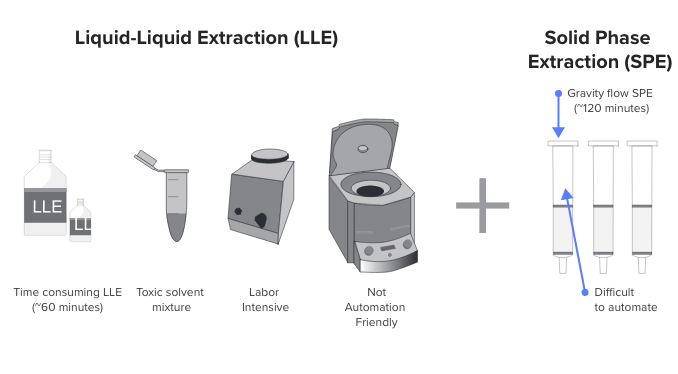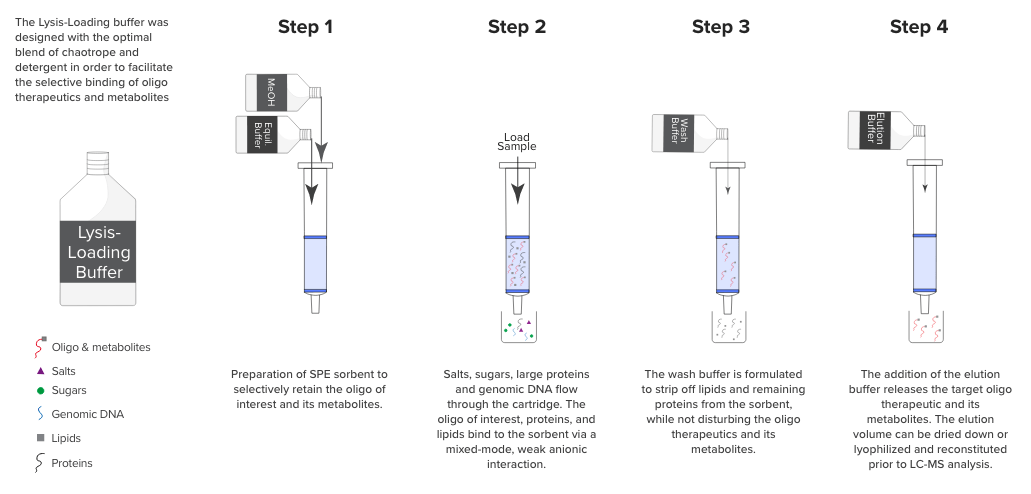Product Information
Phase Detail
Clarity OTX
Clarity OTX solid phase extraction tubes allow for the isolation of RNA and DNA-based therapeutics
Clarity OTX
Clarity OTX

15 Minute Clean Up from Biological Samples
Isolate RNA and DNA-based therapeutics / metabolites from biological fluids and tissues in less time with Clarity OTX solid phase extraction (SPE) and buffer products.
- No liquid-liquid extraction (LLE) required required
- >80 % typical extraction recoveries
- Optimized for LC-MS bioanalysis
U.S. Patent No. 7,119,145

Brand Clarity (SPE) |
Recommended Use Extraction of RNA and DNA-based therapeutics/metabolites from biological fluids and tissues |
General Extraction
Common Extraction Procedure (~180 minutes)

Suitable for Most Oligo Therapeutics & Samples
| Oligo types | Sample Types |
|---|---|
| DNA | Plasma |
| Aptamers | Serum |
| RNAi/siRNA | Urine |
| Thioates | Tears |
| Lipid-conjugates | Saliva |
| Liposome encapsulated |
Tissue |
Extraction Protocol
| Sample Pre-Treatment | |
|---|---|
| Tissue |
|
| Biological Fluids |
|

Detect Low Dosage Levels
Due to the typical 80 % and greater recoveries of the parent oligonucleotide therapeutic and its metabolites, detection in the picomole range is possible. The TIC below illustrates detection of a dosage in this very sensitive range. Aliquots of 500 ng & 50 ng spiked into plasma were extracted using Clarity OTX to determine sensitivity limits. A TIC of the 500 ng load is shown below. The 14.3 minute peak corresponding to the 19mer P-S can be quantitated. While a peak is not observed for the TIC of the 50 ng load, using a XIC at m/z of 944 (the -7 charge state) one can still quantitate the oligonucleotide at very low levels.
Sensitivity Study in Plasma

|
Column:
Clarity 3 µm Oligo-RP C18
|
|
Dimension:
50 x 4.6 mm
|
|
Part No.:
00B-4441-E0
|
|
Mobile Phase:
A: 50 mM TEAA, pH 7.5 / 5 % Acetonitrile
B: Methanol |
|
Gradient:
A/B (90:10) to A/B (40:60) in 20 min
|
|
Flow Rate:
1 mL/ min
|
|
Detection:
UV @ 260 nm
|
|
Sample:
25nt DNA oligonucleotide
|
UV chromatograms of oligonucleotide extracted from liver tissue using Clarity OTX. The 19mer extracted phosphorothioate oligonucleotide was spiked with 10 µg of a oligonucleotide internal standard before analysis. The top two chromatograms represent different levels of the incubated P-S oligo. The bottom chromatogram is an external standard of equal amounts of the 19mer oligo and internal standard. Note the high recovery of the oligonucleotide and low level of plasma contaminants from the incubated samples.
Sensitivity Study in Live Tissue

The level of MS sensitivity is highly linked to the MS instrument and HPLC mobile phase used. Contact Phenomenex for questions about sensitivity levels achieved with Clarity OTX on various instruments with specific mobile phases.












